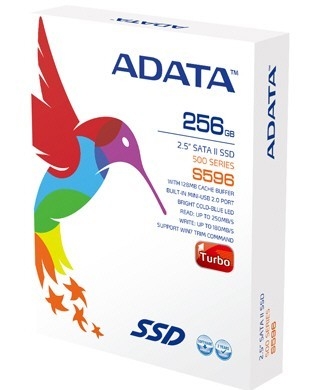ADATA's S596 Turbo SSD Offers Two Interfaces
The new ADATA S596 turbo series offers both SATA II and mini-USB.
Monday ADATA Technology officially announced the S596 Turbo series of 2.5-inch solid state disks, the first line of SSDs to use the new JMicron JMF616 controller. The drives are said to deliver sequential read and write speeds up to 250 MB/sec and 180 MB/sec, and provide users with two interface options: SATA II and mini-USB.
"The SSD can be used either as an external portable storage, or as an installed disk in laptop," the company said. "Furthermore, with a 3.5-inch converter, the S596 Turbo can be installed in desktop PC. The brushed aluminum chassis of the S596 Turbo is designed for fast heat dissipation, while bringing impressive elegant demeanor."
Utilizing the next generation of flash technology, the S596 Turbo series uses a DDR2 128M cache buffer and supports Windows 7 TRIM command. The new controller adds extra stability while Static wear-leveling technology extends the SSD's life. The drives even come with a 60-day trial of Norton Internet Security 2010 and a three-year product warranty.
As for storage capacities, the new S596 Turbo line will come in three varieties: 64GB, 128GB, and 256GB. The press release lists a 32GB version, however the product page does not. All three listed drives are compatible with Windows 7 and Mac Snow Leopard, and promises a 40-percent performance improvement compared to platforms equipped with ordinary SSDs.
ADATA did not specify pricing or availability.
Get Tom's Hardware's best news and in-depth reviews, straight to your inbox.

Kevin Parrish has over a decade of experience as a writer, editor, and product tester. His work focused on computer hardware, networking equipment, smartphones, tablets, gaming consoles, and other internet-connected devices. His work has appeared in Tom's Hardware, Tom's Guide, Maximum PC, Digital Trends, Android Authority, How-To Geek, Lifewire, and others.
-
adamspc ReplyAll three listed drives are compatible with Windows 7 and Mac Snow Leopard, and promises a 40-percent performance improvement compared to platforms equipped with ordinary SSDs.
Dang it. I just now bought an ordinary SSD. -
Simple11 Yeah, what squiggs said, kinda kills the performance. Anyhow, I would love one of these for my desktop maybe 2 of them in RAID0 :D ... too bad there is no price listed yet.Reply -
balister Why can't the SSD manufacturers move to SATA3 and USB3. SSDs are already saturating SATA2 and USB2.Reply -
hellwig USB 2.0 SSD huh? Not really sure how that's practical. It might make a more "stable" mobile backup drive, but I think people don't give physical drives enough credit in that respect. When was the last time the harddrive in your laptop, netbook, or first-gen iPod gave out? Never? Then maybe a cheaper, adequately fast for USB 2.0 HDD will work just as well.Reply
As for going from SATA to USB, its much more practical to use an adapter than pay extra for a drive that includes both interfaces. I mean, sure, you might use eSATA on a desktop, then USB on a laptop, but again, use an adapter (Scythe makes a quality one for like $30). -
adamspc ReplyWhen was the last time the harddrive in your laptop, netbook, or first-gen iPod gave out? Never?
Last week. -
nforce4max I have been needing one of these SSD drives for my bloated page file while I quad log wow or play gta iv.Reply -
Darkerson squiggs77Anyone who wants an external SSD isn't going to want to use USB 2.0.Reply
Maybe not, but at least its an option. Id rather have it there and not use it then vice-versa. Im sure they'll move to USB3 soon enough, but its still rather new, and the installed base with USB2 completely dwarfs it in comparison. -
warmon6 ReplyWhen was the last time the harddrive in your laptop, netbook, or first-gen iPod gave out? Never?
Laptop, 2 years go. Desktop 5 years ago and few more desktop HDD beyond that. Maybe having one going out here soon but it an old laptop with nothing important on it.
Although i can see the importance of ssds. Seen some tornado chasers on tv trying to collect data on them and a major bump in the road stop the hdd in the laptop there using . Required a reboot to get things going again although if i remember right, the tornado roped out by the time the computer rebooted. So any radar data that the computer could of collected wasn't there.
